View in other NatureServe Network Field Guides
NatureServe
Montana
Utah
Wyoming
Idaho
Wisconsin
British Columbia
South Carolina
Yukon
California
New York
Swamp Milkweed - Asclepias incarnata
State Rank Reason (see State Rank above)
Known in Montana from Carbon County. One of the known sites is likely extirpated. Additional information is needed on the species' distribution, abundance, potential trends and threats within Montana.
General Description
Fibrous-rooted. Stems simple to branched, 70–100 cm. Herbage glabrous to puberulent on the stem. Leaves opposite, spreading; blades lanceolate, 4–15 cm long. Umbels of 10 to 40 flowers; peduncles 1–7 cm long. Flowers 9–11 mm high; sepals villous, 1–2 mm long; petals purplish, glabrous, 5–6 mm long; gynostegium pink, glabrous, 1–2 mm high; hoods oblong, 2–3 mm long; horns exserted, arching. Follicles erect, fusiform, 5–8 cm long, smooth, mostly glabrous (
Lesica et al. 2012. Manual of Montana Vascular Plants. BRIT Press. Fort Worth, TX).
Our plants are variety
incarnata.
Phenology
Flowering in July.
Diagnostic Characteristics
The combination of acute leaves >4 mm wide and slender horns longer than the hoods distinguish Asclepias incarnata from other Montana milkweeds. Asclepias speciosa also has pinkish corollas and occupies wetland habitat, but has large hoods that surpass the horns.
Species Range
Montana Range
Range Descriptions
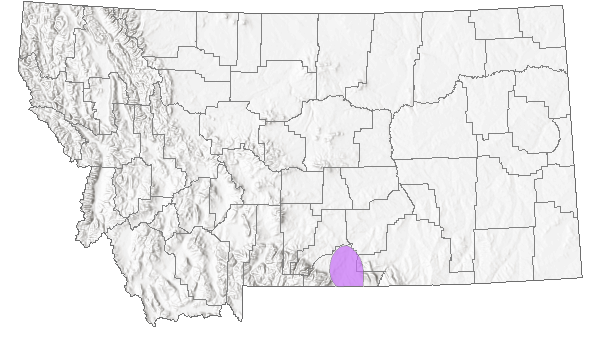
 Native
Native
Range Comments
SK to NS south to NM and FL. Known from Carbon County (Lesica et al. 2012. Manual of Montana Vascular Plants. BRIT Press. Fort Worth, TX). In Montana, native populations appear to be limited to the Clarks Fork of the Yellowstone drainage. The species is planted in other areas and may spread further from these plantings. As such, additional observations are expected outside of its suspected native range.
Observations in Montana Natural Heritage Program Database
Number of Observations: 13
(Click on the following maps and charts to see full sized version)
Map Help and Descriptions
Relative Density
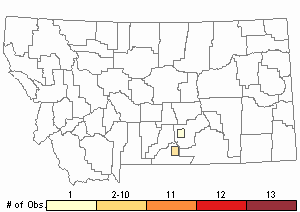
Recency
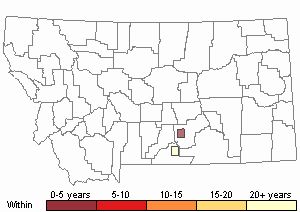

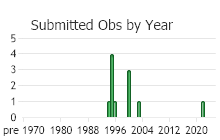
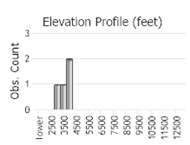 (Observations spanning multiple months or years are excluded from time charts)
(Observations spanning multiple months or years are excluded from time charts)
Habitat
Wet meadows and thickets.
National Vegetation Classification System Groups Associated with this Species
Wetland and Riparian
Alkaline - Saline Wetlands
Riparian and Wetland Forest
Riparian Shrubland
Wet Meadow and Marsh
Ecology
POLLINATORS The following animal species have been reported as pollinators of this plant species or its genus where their geographic ranges overlap:
Bombus vagans,
Bombus huntii,
Bombus rufocinctus,
Bombus ternarius,
Bombus terricola,
Bombus pensylvanicus,
Bombus bimaculatus,
Bombus griseocollis,
Bombus impatiens,
Bombus insularis, and
Bombus flavidus (Plath 1934, Heinrich 1976, Thorp et al. 1983, Colla and Dumesh 2010, Colla et al. 2011, Koch et al. 2012, Williams et al. 2014, Tripoldi and Szalanski 2015).
Stewardship Responsibility
Threats or Limiting Factors
STATE THREAT SCORE REASON
Threat impact not assigned because threats are not known (MTNHP Threat Assessment 2021).
References
- Literature Cited AboveLegend:
 View Online Publication
View Online Publication Colla, S., L. Richardson, and P. Williams. 2011. Bumble bees of the eastern United States. Washington, DC: USDA Forest Service, Pollinator Partnership. 103 p.
Colla, S., L. Richardson, and P. Williams. 2011. Bumble bees of the eastern United States. Washington, DC: USDA Forest Service, Pollinator Partnership. 103 p. Colla, S.R. and S. Dumesh. 2010. The bumble bees of southern Ontario: notes on natural history and distribution. Journal of the Entomological Society of Ontario 141:39-68.
Colla, S.R. and S. Dumesh. 2010. The bumble bees of southern Ontario: notes on natural history and distribution. Journal of the Entomological Society of Ontario 141:39-68. Koch, J., J. Strange, and P. Williams. 2012. Bumble bees of the western United States. Washington, DC: USDA Forest Service, Pollinator Partnership. 143 p.
Koch, J., J. Strange, and P. Williams. 2012. Bumble bees of the western United States. Washington, DC: USDA Forest Service, Pollinator Partnership. 143 p. Lesica, P., M.T. Lavin, and P.F. Stickney. 2012. Manual of Montana Vascular Plants. Fort Worth, TX: BRIT Press. viii + 771 p.
Lesica, P., M.T. Lavin, and P.F. Stickney. 2012. Manual of Montana Vascular Plants. Fort Worth, TX: BRIT Press. viii + 771 p. MTNHP Threat Assessment. 2021. State Threat Score Assignment and Assessment of Reported Threats from 2006 to 2021 for State-listed Vascular Plants. Botany Program, Montana Natural Heritage Program, Helena, Montana.
MTNHP Threat Assessment. 2021. State Threat Score Assignment and Assessment of Reported Threats from 2006 to 2021 for State-listed Vascular Plants. Botany Program, Montana Natural Heritage Program, Helena, Montana. Plath, O.E. 1934. Bumblebees and their ways. New York, NY: Macmillan Company. 201 p.
Plath, O.E. 1934. Bumblebees and their ways. New York, NY: Macmillan Company. 201 p. Thorp, R.W., D.S. Horning, and L.L. Dunning. 1983. Bumble bees and cuckoo bumble bees of California (Hymenoptera: Apidae). Bulletin of the California Insect Survey 23:1-79.
Thorp, R.W., D.S. Horning, and L.L. Dunning. 1983. Bumble bees and cuckoo bumble bees of California (Hymenoptera: Apidae). Bulletin of the California Insect Survey 23:1-79. Tripoldi, A.D. and A.L. Szalanski. 2015. The bumble bees (Hymenoptera: Apidae: Bombus) of Arkansas, fifty years later. Journal of Melittology 50: doi: http://dx.doi.org/10.17161/jom.v0i50.4834
Tripoldi, A.D. and A.L. Szalanski. 2015. The bumble bees (Hymenoptera: Apidae: Bombus) of Arkansas, fifty years later. Journal of Melittology 50: doi: http://dx.doi.org/10.17161/jom.v0i50.4834 Williams, P., R. Thorp, L. Richardson, and S. Colla. 2014. Bumble Bees of North America. Princeton, NJ: Princeton University Press. 208 p.
Williams, P., R. Thorp, L. Richardson, and S. Colla. 2014. Bumble Bees of North America. Princeton, NJ: Princeton University Press. 208 p.
- Additional ReferencesLegend:
 View Online Publication
View Online Publication
Do you know of a citation we're missing? Heidel, B. 1994. Potential impact of proposed noxious weed treatment at Bluewater Fish Hatchery (MDFWP) on plant species of special concern. Unpublished report to Gary Shaver, Bluewater Fish Hatchery. Montana Natural Heritage Program, Helena, Montana. 5 pp.
Heidel, B. 1994. Potential impact of proposed noxious weed treatment at Bluewater Fish Hatchery (MDFWP) on plant species of special concern. Unpublished report to Gary Shaver, Bluewater Fish Hatchery. Montana Natural Heritage Program, Helena, Montana. 5 pp. Lesica, P., M.T. Lavin, and P.F. Stickney. 2022. Manual of Montana Vascular Plants, Second Edition. Fort Worth, TX: BRIT Press. viii + 779 p.
Lesica, P., M.T. Lavin, and P.F. Stickney. 2022. Manual of Montana Vascular Plants, Second Edition. Fort Worth, TX: BRIT Press. viii + 779 p.
- Web Search Engines for Articles on "Swamp Milkweed"





